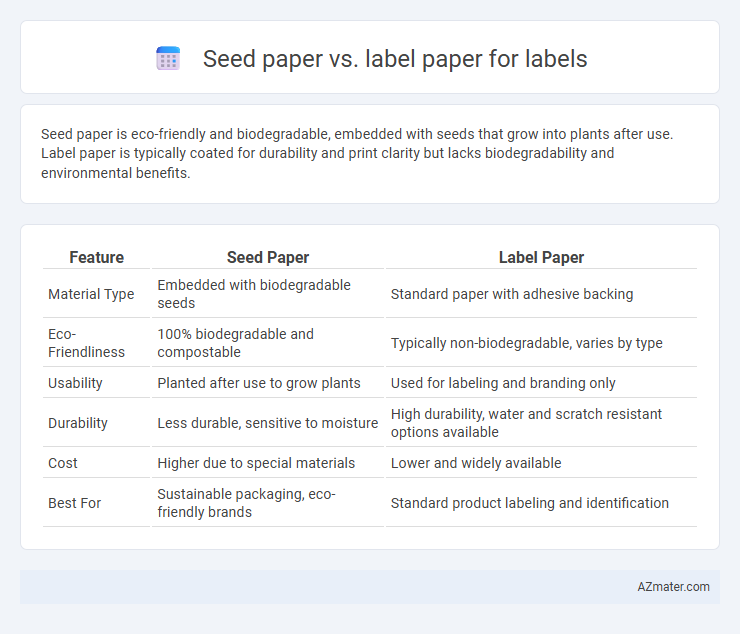Seed paper is eco-friendly and biodegradable, embedded with seeds that grow into plants after use. Label paper is typically coated for durability and print clarity but lacks biodegradability and environmental benefits.
Table of Comparison
| Feature | Seed Paper | Label Paper |
|---|---|---|
| Material Type | Embedded with biodegradable seeds | Standard paper with adhesive backing |
| Eco-Friendliness | 100% biodegradable and compostable | Typically non-biodegradable, varies by type |
| Usability | Planted after use to grow plants | Used for labeling and branding only |
| Durability | Less durable, sensitive to moisture | High durability, water and scratch resistant options available |
| Cost | Higher due to special materials | Lower and widely available |
| Best For | Sustainable packaging, eco-friendly brands | Standard product labeling and identification |
Introduction to Seed Paper and Label Paper
Seed paper is an eco-friendly material embedded with seeds that can be planted after use, promoting sustainability and reducing waste. Label paper, traditionally made from coated or uncoated paper, serves as a durable medium for printing adhesive labels used in packaging, branding, and product identification. Both types offer distinct advantages--seed paper supports environmental initiatives while label paper provides strong adhesion and print clarity tailored to commercial needs.
What is Seed Paper?
Seed paper is an eco-friendly, biodegradable material embedded with seeds that grow into plants when planted in soil, making it a sustainable alternative to traditional label paper. Unlike conventional label paper, which is typically made from plastic or non-recyclable materials, seed paper promotes environmental conservation by reducing waste and supporting biodiversity. This innovative paper type is ideal for labels that combine marketing with eco-conscious messaging, enhancing brand image while encouraging customer engagement through planting.
What is Traditional Label Paper?
Traditional label paper is a standard paper material coated with adhesive on one side, designed for easy printing and application on various surfaces. It typically features a smooth or matte finish suitable for inkjet or laser printers, allowing for sharp text and vibrant graphics on product labels, shipping tags, and promotional stickers. Unlike seed paper, which contains embedded seeds for planting, traditional label paper prioritizes durability and print quality without environmental integration.
Environmental Impact: Seed Paper vs Label Paper
Seed paper significantly reduces environmental impact by being biodegradable and embedded with plantable seeds that promote reforestation. Traditional label paper often involves plastic coatings and non-recyclable adhesives, contributing to landfill waste and pollution. Using seed paper labels supports sustainability efforts by encouraging plant growth and reducing dependency on synthetic materials.
Biodegradability and Sustainability Comparison
Seed paper offers superior biodegradability compared to conventional label paper by decomposing naturally and enriching soil with embedded seeds, promoting sustainability through plant growth. Label paper, often coated or treated for durability, typically contains synthetic additives that slow decomposition and contribute to environmental waste. Selecting seed paper labels significantly reduces ecological impact and supports circular economy practices by combining functionality with renewable, compostable materials.
Print Quality and Design Considerations
Seed paper offers a unique textured surface that can impact print clarity, often requiring specialized inks and printing techniques to maintain vibrancy, while label paper provides a smoother finish allowing for crisp, high-resolution prints ideal for detailed graphics and fine text. Design considerations for seed paper must account for its biodegradable, fibrous content which may cause slight ink bleed or uneven surfaces, contrasting with label paper's uniform coating that supports consistent color reproduction and sharper design elements. Choosing between seed paper and label paper depends on balancing eco-friendly appeal with the need for precise print quality and complex design features.
Cost Analysis: Seed Paper vs Label Paper
Seed paper costs are generally higher due to eco-friendly materials and embedded seeds, making production more complex than traditional label paper. Label paper benefits from mass production efficiencies, resulting in lower per-unit costs ideal for large-scale labeling needs. Choosing seed paper supports sustainability initiatives but requires balancing budget constraints against environmental impact goals.
Applications and Usability in Labeling
Seed paper offers eco-friendly labeling solutions ideal for sustainable product packaging, enabling consumers to plant the label after use, which enhances brand environmental impact. Label paper provides versatile and durable options suitable for various surfaces, including retail packaging, shipping, and barcode labeling, ensuring strong adhesion and print clarity. Both materials excel in applications demanding specific usability: seed paper for green marketing and biodegradable labels, while label paper supports high-volume, cost-effective labeling needs.
Consumer Perception and Branding
Seed paper enhances consumer perception by symbolizing eco-friendliness and sustainability, resonating with environmentally conscious audiences and strengthening brand authenticity. Label paper offers versatility and sharp print quality, enabling brands to deliver clear, professional messaging and maintain consistent visual identity across products. Brands embracing seed paper often experience increased customer loyalty due to its unique, interactive nature that encourages positive brand engagement and social responsibility.
Choosing the Right Paper for Your Labeling Needs
Seed paper enhances sustainability by embedding biodegradable seeds, making it ideal for eco-friendly labels that promote brand values and environmental responsibility. Label paper, available in various finishes such as glossy, matte, or clear, offers versatility and durability essential for product identification, marketing, and compliance across industries. Selecting the right paper depends on factors such as label purpose, durability requirements, environmental impact, and branding goals to optimize functionality and consumer appeal.

Infographic: Seed paper vs Label paper for Label
 azmater.com
azmater.com